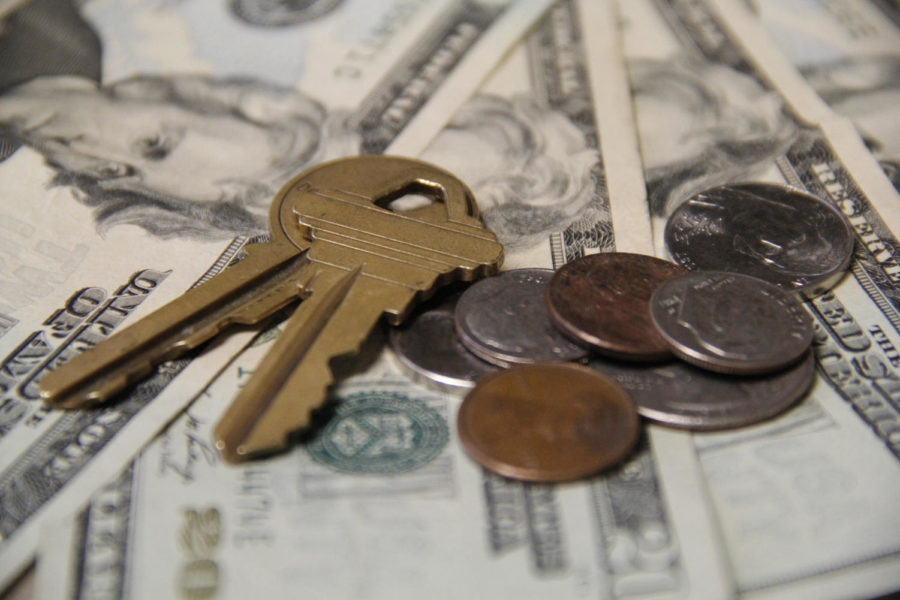Skyrocketing rent: Housing rates increase as university grows
Illustration: Kelby Wingert/Iowa State Daily
money shot 1.jpg
July 30, 2014
Rental prices in Ames have been increasing for years and the basic economic principle of supply and demand is the explanation.
The question facing ISU students — many of whom now pay rental prices similar to those found in parts of the Des Moines metro area and have a difficult time finding a one-bedroom apartment for less than $700 a month — is why are rental prices continuing to rise?
The reason
Peter Orazem, university professor of economics, said the answer lies in the number of students looking for housing in Ames.
“It is an issue of market supply versus market demand,” Orazem said. “For roughly 25 years, Iowa State ranged between 25,000 and 27,000 students with no real appreciable growth or decline.
“My guess is this year it will be in the neighborhood of 35,000 students. We are adding on average 1,000 plus students a year over a short period of time and it took a while for the market to adjust to that growth.”
The force behind the market adjustments are the firms, in this case housing entities, who raise their prices to maximize value.
“If you are a housing manager, any vacant apartment is a cost to you,” Orazem said. “On the other hand, you do not want to underprice your products, so you are going to try to price at whatever you think is the highest price you can charge and still rent all your units.”
While Iowa State scrambles to provide enough university-based housing for the rapid influx of students pouring in Ames, landlords in town find themselves in a favorable position to increase profits. But not all housing price increases are created equal.
“We do not raise prices across the board,” said Ben Wichtendahl, leasing coordinator with Campustown Property Management. “We base all of our rates on the market [for each specific type of unit].”
Laura Kilbride, community manager of University West Properties, explained why rental units may increase at different rates, or even decrease in a market that is currently seeing most rental prices being driven upwards.
“University West tracks how quickly each type of apartment is leasing every week,” Kilbride said in an email. “If a certain floor plan is moving very quickly … its price might increase, even during the leasing season. And if a floor plan is moving too slowly, the property will typically offer concessions to decrease the market rent and make that floor plan more attractive in the mix.”
As Kilbride describes it, rental pricing in Ames may not only increase each year, but actually each week based on trends, and with more students arriving at Iowa State each year, it may benefit those seeking to rent who also want options to sign a lease as quickly as possible.
However, it is a game of risk. Waiting could also provide a price decline to any units that remain unrented as the start of the school year approaches. The selection will be smaller and the amenities less attractive, but the prices may also dip.
The numbers
As far as the yearly price ranges are concerned, the jump from 2012-13 to 2013-14 has been noticeable.
Wichtendahl said that at Campustown Properties, the ranges have bumped between $5 to $20 per month per unit across the different units offered. Campustown offers everything from one-bedroom units to five-bedroom units.
At Haverkamp Properties, situated mostly in west Ames, leasing agent Kade Olson said that one-bedroom prices rose about $25 per month on average. He added that prices for multi-bedroom apartments may have risen higher than $25 per month overall, but tend to level out at about $20 extra per month per person when there are multiple renters.
“The combination of the very rapid increase in students who are at one particular part of the market, which is primarily rental housing, combined with the constraints on Ames being able to annex more land … probably has had the effect of at least short term bidding up the price of apartments,” Orazem said. “We are getting complaints regarding more rapid increases in housing prices than what people were used to.”
The future
Orazem said that the laments of students may soon become rejoicings as the trend of rental prices being pressed upward may be about to change.
When a market grows as quickly as the Ames housing market has grown during the last handful of years, the demand rises and the supply stays roughly the same in the short term.
Yet in the long term, other firms see an opportunity and enter the market and capitalize, which then ends up benefiting the consumers, in this case student renters. The other firms press prices downward.
“Whatever the demand is, if you increase supply the price will go down,” Orazem said. “You will also start to see some of the older rental units losing their ability to price so you may find that some houses that had been converted into rentals are going to convert back to owner-occupied down the road.”
Wichtendahl said there are numerous new complexes being built around Ames, which will add more competition to the market and will help to level out prices — something Orazem echoed.
“I would not be surprised with as much housing as is going to come online next year, if you [saw] some give back on prices,” Orazem said. “As the newer complexes come online you are going to see more competition and some of the increases this year may be reversed as early as a year from now.”

















